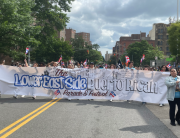LGBTQ rights opposition indicates the opposition to legal rights, proposed or enacted, for lesbian, gay, bisexual, and transgender (LGBT) people. Laws that LGBTQ rights opponents may be opposed to including civil unions or partnerships, LGBT parenting and adoption, military service, access to assisted reproductive technology, and access to sex reassignment surgery and hormone replacement therapy for transgender individuals.
Organizations influential in LGBT rights opposition frequently oppose the enactment of laws making same-sex marriage legal, the passage of anti-discrimination laws aimed at curtailing anti-LGBT discrimination, including in employment and housing, the passage of anti-bullying laws to protect LGBT minors, laws decriminalizing same-gender relationships, and other LGBT rights-related laws. These groups are often religious or socially conservative in nature. Such opposition can be motivated by homophobia, transphobia, bigotry, animosity, religion, moral beliefs, political ideologies, or other reasons.
The first organized gay rights movement arose in the late nineteenth century in Germany. In the 1920s and into the early 1930s, there were LGBT communities in cities like Berlin; German-Jewish sexologist Magnus Hirschfeld was one of the most notable spokespeople for LGBT rights at this time. When the Nazi party came to power in 1933, one of the party’s first acts was to burn down Hirschfeld’s Institut für Sexualwissenschaft, where many prominent Nazis had been treated for perceived sexual problems. Initially tolerant to the homosexuality of Ernst Röhm and his followers, many gay men were purged from the Nazi Party following the Night of the Long Knives and the Section 175 Laws began to be enforced again, with gay men interned in concentration camps by 1938.
Under Nazi rule in Germany, the dismantling of rights for LGBT individuals was approached in two ways. By strengthening and re-enforcing existing laws that had fallen into disuse, male homosexuality was effectively re-criminalized; homosexuality was treated as a medical disorder, but at a social level rather than an individual level intended to reduce the incidence of homosexuality. The treatment was a program of eugenics, starting with sterilization, then a system of working people to death in forced labor camps, and eventually refined by medical scientists to include euthanasia. The driving force was the elimination of perceived degeneracy at various levels – genetic, social, identity, and practice.
It is argued that the number of gay people who perished in the Holocaust was quite low in comparison to other Holocaust victims, and confined to Germany itself, based on estimates that of 50,000 gay people who came before the courts, between 5,000 and 15,000 ended up in concentration camps. However, many of those who came before the courts were directed (or volunteered) to undergo sterilization/castration; they would be included with others who, in line with the historic shift in German society (that started with Westphal, and developed through Krafft-Ebing to Magnus Hirschfeld, of homosexuality being seen as having a neurological, endocrinological or genetic basis), were treated for homosexuality as a medical rather than a criminal matter.
Photo by Clem Onojeghuo on Unsplash







Add Comment
You must be logged in to post a comment.